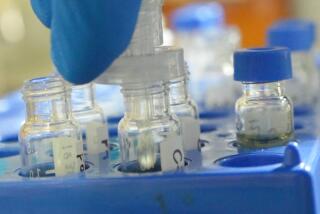Group’s Drug Testing at Raves Raises Concerns
OAKLAND — Until he started offering to test tablets of Ecstasy--the antidepressant that is rapidly becoming the illicit drug of choice among today’s young people--Emanuel Sferios hadn’t even been to a rave.
Sferios’ tastes ran more to punk rock, not the techno and house music whose pounding electronic beats--together with the practically universal use of Ecstasy, or MDMA--fuels the turbulent, dance-till-dawn vortex of rave culture. But nowadays, Sferios and Dance Safe, the group he founded, are becoming fixtures at the all-night dance parties in the Bay Area.
In San Francisco’s trendy South of Market district and in abandoned Oakland warehouses, Dance Safe sets up its tables and distributes information on various drugs. And the volunteers also offer to test Ecstasy tablets for anyone who wants to know if their drugs are genuine--or substitutes that can be even more dangerous.
Sferios, a 30-year-old student at Berkeley’s Graduate Theological Union, calls it “harm reduction,” characterizing his group’s efforts as “an addition to the ‘just say no’ ” model of deterrence.
But critics compare Dance Safe’s drug testing to programs that distribute clean needles to intravenous drug addicts or condoms to high school students. They charge that such policies, instead of deterring bad behavior, encourage it.
Joycelyn Barnes of the federal Drug Enforcement Agency said that even Dance Safe’s name gives drug users the wrong impression. “Any organization that deals with these types of parties and young people could better use their energies on discouraging drugs rather than encouraging them,” she said.
San Francisco narcotics Officer John Keane said the organization does little to discourage drug use.
“That whole scene encourages people to do drugs, and they’re just part of it,” he said. “According to them, they counsel people on the evil of drugs. I hope they do that. But in that whole scene, I don’t think anyone would be talked out of doing them. There are hundreds of people down there dancing away.”
The danger of adulterated Ecstasy is quite real. Last summer, eight dancers at one party were admitted to the city’s emergency rooms complaining of heat exhaustion. Instead of Ecstasy, they had taken pills containing DXM, a cough suppressant that in high doses can prevent sweating, which in turn contributes to heatstroke--the leading cause of death at rave parties, according to Sferios.
And in Hayward last month, a San Francisco police officer was accused of selling fake Ecstasy. Chris Greenman, a five-year police veteran, was placed on unpaid leave and is facing departmental charges.
Beyond warning dancers away from substitute drugs, the testing “tends to clean up the market a bit,” Sferios said. “When we tell a person their pill is DXM, usually what they’ll do is go back to the dealer and try to get their money back. If we have a presence at the event, usually the scam dealers won’t go there.”
Sferios founded Dance Safe in Berkeley last year with $3,000 of his own money. Long involved in social work, he saw that the rave community was not being served by other organizations, and that there was a need to teach dancers about Ecstasy and its risks.
Along with a Web site--https://www.dancesafe.org--the organization has an office in Oakland, four full-time staffers and chapters in Los Angeles; Seattle; Boston; Pittsburgh; Portland, Ore.; and Vancouver, British Columbia, Canada. The group’s $500,000 annual budget is made up largely of donations from ‘dot-com’ entrepreneurs.
“They’re young millionaires . . . and they came of age in the rave scene and made most of their friends there. Some of them are Ecstasy users themselves,” Sferios said. “They’re ravers and they want to give back to their community.”
Volunteers scrape off a small sample from a tablet and mix it with chemicals to verify that it is Ecstasy.
The testing “is aimed at people who are already using or are going to make the choice to do drugs,” Sferios said.
“ ‘Just say no’ works well for young people and those who are very risk-avoidant,” he said. “But some of us are novelty seekers by nature. Youth experimentation with drugs simply happens. For those people that start, they need accurate, truthful information, with the understanding that there is no such thing as 100% safe drug use.”
Most law enforcement agencies have tolerated Dance Safe’s drug-testing program. Indeed, it couldn’t have succeeded at all if not for the cooperation of police, who have agreed to observe an amnesty zone around Dance Safe’s testing tables.
Aside from attending to the traffic problems they cause, the Oakland police haven’t been “proactively investigating” raves, said Lt. Rick Hart, who gives Dance Safe guarded approval. “I don’t want to see any of these young people die because of adulterated drugs. My preference is they not consume it at all. For safety purposes, if someone is testing it and they’re finding there are some dangerous chemicals, it’s best that they catch it than have young people dying in the community.”
In San Francisco, Lt. Kitt Crenshaw, a 17-year police narcotics officer, said Dance Safe’s drug testing “is a good idea. I would have no fight with that. If people are going to partake, at least they should be smart about what they’re putting into their system.”
The city’s Department of Health supports Dance Safe. “The department supports intervention efforts which raise public awareness of the risks of drug use and which use harm-reduction strategies to prevent the often fatal consequences of such use,” San Francisco health official Alice Gleghorn said.
More to Read
Sign up for Essential California
The most important California stories and recommendations in your inbox every morning.
You may occasionally receive promotional content from the Los Angeles Times.










